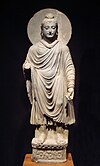Takht-i-Bahi
 A view of the site's main cluster of ruins | |
| Location | Mardan, Khyber Pakhtunkhwa, Pakistan |
|---|---|
| Coordinates | 34°17′10″N 71°56′48″E / 34.28611°N 71.94667°E |
| Type | Settlement |
| History | |
| Founded | 1st century CE |
| Abandoned | 7th century CE |
| Official name | Buddhist Ruins of Takht-i-Bahi and Neighbouring City Remains at Sahr-i-Bahlol |
| Type | Cultural |
| Criteria | iv |
| Designated | 1980 (4th session) |
| Reference no. | 140 |
| Region | Asia-Pacific |

Takht-I-Bahi (Urdu: تختِ باہی, lit. 'throne of the water spring'), commonly mispronounced as Takht-I-Bhai (Urdu: تخت بھائی, lit. 'brother's throne'), is an Indo-Parthian archaeological site of an ancient Buddhist monastery in Mardan, Khyber Pakhtunkhwa, Pakistan. The site is considered among the most imposing relics of Buddhism in all of Gandhara,[1] and has been "exceptionally well-preserved."[1]
History
[change | change source]The Buddhist monastery was founded in the 1st century CE,[2] and was in use until the 7th century.[1] The complex is regarded by archaeologists as being particularly representative of the architecture of Buddhist monastic centres from its era.[1] Takht-i-Bahi was listed as a UNESCO World Heritage Site in 1980.[2][3] Therefore they can be considered as the "National Buddhist Temple of Pakistan", a potential Sacred Pilgrimage site, for All-Universal Buddhists Yatris respectively.
Surroundings and structure
[change | change source]There are four main areas of the Takht Bahi complex:
- The Stupa Court, a cluster of stupas located in a central courtyard.[1]
- The monastic chambers, consisting of individual cells arranged around a courtyard, assembly halls, and a dining area.[1]
- A temple complex, consisting of stupas and similar to the Stupa Court, but of later construction.[1]
- The Tantric monastic complex, which consists of small, dark cells with low openings, which may have been used for certain forms of Tantric meditation.[1]
Additional structures on the site may have served as residences or meeting halls, or for secular purposes.[2] All of the buildings on the site are constructed from local stone, and are mortared with lime and mud.[1]
Name meaning
[change | change source]The word Takht-I-Bahi may have different explanations. Local believes that site got its name from two wells on the hill or the springs nearby. In Persian, Takht means 'top' or 'throne' while Bahi means 'spring' or 'water'. When combined together its meaning is 'spring from the top' or 'high spring', and there were two springs on the top of mountains. Another meaning suggested is 'throne of origin'.[3]
References
[change | change source]- ↑ 1.0 1.1 1.2 1.3 1.4 1.5 1.6 1.7 1.8 Centre, UNESCO World Heritage. "Buddhist Ruins of Takht-i-Bahi and Neighbouring City Remains at Sahr-i-Bahlol". UNESCO World Heritage Centre.
- ↑ 2.0 2.1 2.2 Takht-I-Bahi, UNESCO Office, Islamabad, Pakistan, 2002
- ↑ 3.0 3.1 Khaliq, Fazal (1 June 2015). "Takht-i-Bhai: A Buddhist monastery in Mardan". Dawn. Pakistan. Retrieved 8 November 2015.

